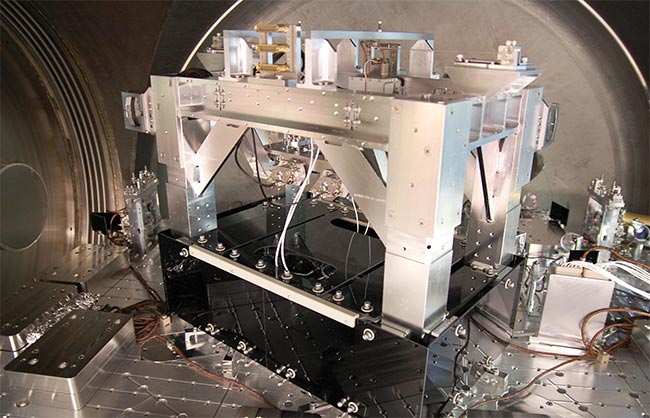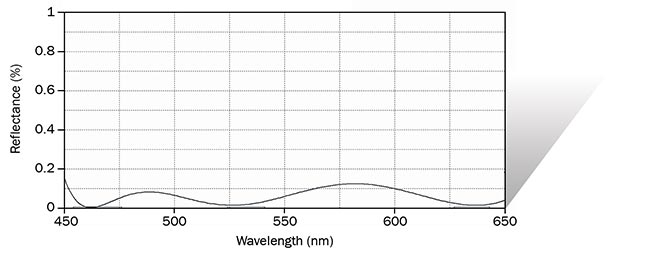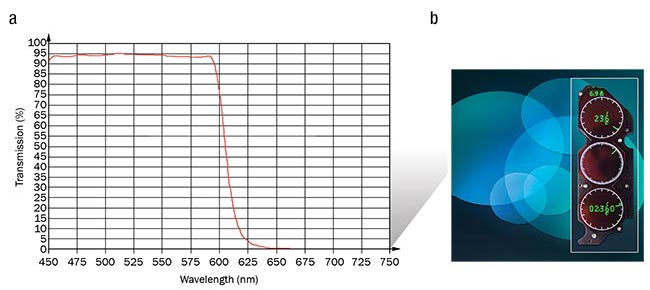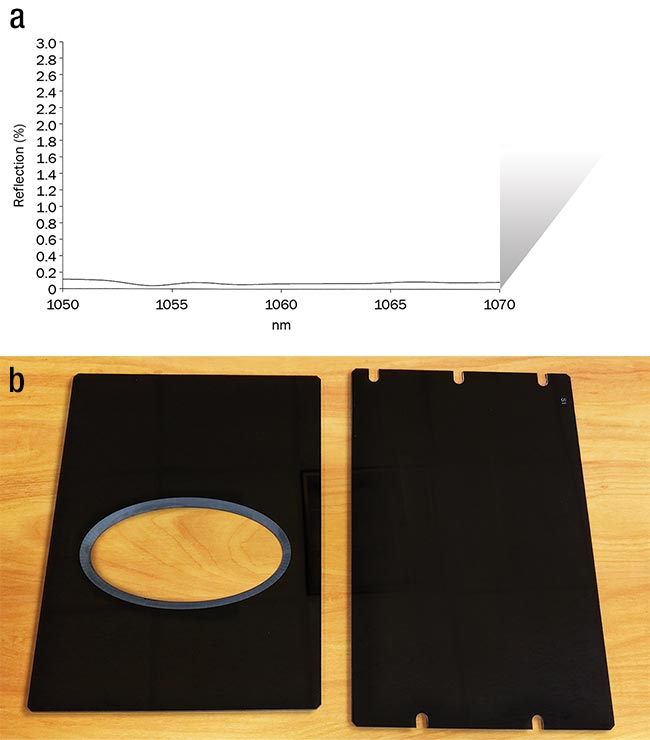
Custom Optical Coatings for Cinema, Avionics, and LIGO
High-precision optical systems require specialized components, which can often be manufactured at a cost comparable to off-the-shelf optics.
By Daniel Bukaty Jr.
Commercial off-the-shelf (COTS) optical components such as filters, beamsplitters, prisms, and mirrors are used in numerous applications, including machine vision, microscopy, and optical test and measurement. These components are often coated with specialized materials that enhance their performance across the UV, visible, and IR spectra.
COTS components, which optics systems designers will order on an ad hoc basis, are generally made to perform simple functions — for example, a single-wavelength bandpass filtering in the 380- to 740-nm wavelength range. To meet demand, optical component manufacturers and/or distributors must carry sufficient inventory of each product in a range of sizes and wavelengths, which can result in a high cost per item. The high price is also partially due to the fact that manufacturers must maintain a large optical glass inventory.

Antireflection black glass panels were customized and installed in the LIGO system. Courtesy of Precision Glass & Optics.
System designers may default to COTS products to test a particular optical concept, even though the characteristics differ from those required to meet the project’s actual design specifications. For testing, designers may automatically assume that the cost of customized manufactured products exceeds the price of ready-made COTS optics, but the opposite is often true. Manufacturers can and do supply specialized products of exacting dimensions, substrate widths, and detailed optical characteristics at prices that are frequently comparable to or lower than standard, catalog-based offerings.
To realize maximum savings for specialty optics projects, the optical systems designer and the custom optics manufacturer must work together closely as early in the design phase as possible to determine the project needs, and mutually agree on the approach and specifications.
Three real-world applications in which specialized optics were required to meet design specifications of complex, niche projects — and where cost played a significant role — are considered. The first application — for wide-screen digital cinema projectors — required custom, fused silica integrator rods or light pipes. The second, for military avionics, required customized short-wave bandpass filters. The third specified 100 individually customized antireflection-coated optics for the Laser Interferometer Gravitational-Wave Observatory (LIGO).
A note about software: Specialty software is an industry standard for optimizing the design and manufacture of thin-film coatings. It enables engineers to immediately visualize and assess parameters such as layer thickness, refractive indices, incident angles, wavelengths, and the percentage mixture of the chemical compounds to be used in fabricating the component. It also plays an important role in meeting delivery dates and budgets.
Movie magic
In the design of an optical component for a wide-screen digital cinema application, a broadband antireflection (BBAR) coating was required for a fused silica integrator rod. The cinema projection team designed a system with a hot 1000-W xenon lamp capable of producing a high level of illumination. When reflected from a mirror, the light from the xenon lamp fell upon a digital light projector (DLP), which acted as a spatial light modulator
(SLM), which in turn modulated the amplitude and direction of the incoming light. When driven by electrical signals, the SLM acted as a digital projector for the wide-screen movie projection.
A challenge in designing the system was ensuring that the plane of light presented to the DLP after being reflected from the mirror was as uniform as possible. Without uniformity, the projected image would appear too bright at the center of the screen, and too dark at the periphery. To overcome potential irregularity, engineers specified a 6-in. long, 1/2-in. × 3/4-in. light pipe manufactured of polished rectangular fused silica to evenly correlate light from the mirror to the SLM. The light transmitted through the pipe had to be as efficient as possible. A plain, uncoated optical light pipe could result in a transmission loss of around
8%, which was not acceptable.
To achieve the highest efficiency, a BBAR coating was created. BBAR coatings typically have from 3 to 20, or more, precision layers. In this case, layers of aluminum oxide (Al2O3), hafnium oxide (HfO2), and magnesium fluoride (MgF2) were deposited onto the light pipe via a physical vapor deposition (PVD) process. The PVD process utilized an electron-beam (e-beam) source to evaporate the solid materials in a vacuum environment to form a thin film a few angstroms thick. When complete, the BBAR coating transmitted over 99% of the available light from the xenon lamp, through the light pipe, to the DLP.
Reflectivity measurements of the light pipe were taken with a spectrophotometer, which verified that the required red (R), green (G), and blue (B) wavelengths had a 99% light throughput in the 450- to 650-nm (visible) wavelength range (Figure 1). The final cost of the specialty optics turned out to be significantly less than COTS optics.

Figure 1. An output reading from a spectrophotometer indicates the broadband antireflection (BBAR) optical coating’s extremely high transmission, showing 99% light throughput in the 450- to 650-nm (visible) wavelength range. Courtesy of Precision Glass & Optics.
Although the digital cinema market as a whole is transitioning from xenon lamps to either LED illumination or laser light sources, demand for custom light pipes with specialty coatings will still exist. Custom light pipes ensure uniform transmission over the 450- to 650-nm wavelength range.
Pilot safety
Specialized thin-film optical coatings are in demand in avionics applications where pilots require displays that are consistent in both daytime and nighttime operations. Most of these displays use integral incandescent lamps that back-illuminate the display panel. As such, they emit a large amount of NIR energy that, in military aircraft especially, can interfere with any night-vision systems in the cockpit. To eliminate these wavelengths, short-wave bandpass filters must block any NIR and IR light that is emitted by the displays’ incandescent or LED lamps.
In this avionics application, precision narrow-cone-angle optical filters were designed for an LED-based avionic display. The requirements included a wide range of wavelengths and transmission specifications; the thin-film multilayer coatings consisted of a dozen or more dielectric materials with high and low refraction. The 60- × 120-mm short-wave bandpass filter consisted of approximately 35 to 40 layers of high-index titanium oxide (TiO2) and low-index silicon dioxide (SiO2).
The number of layers, the thickness of each layer, and the order in which they were layered were created with software, which also optimized the layers and thicknesses to ensure that the coating specifications and tolerances were met with the least number of layers possible.
The thin films were then deposited on a glass substrate that was heated to 200 to 250 °C in a high-pressure vacuum (below 10−5 t) using the material e-beam reactive evaporation method in oxygen. The low-energy, ion-beam-assisted deposition (IBAD) permitted durable filters without absorbance and scattering losses, while also enabling high mechanical and chemical resistivity for this application. Importantly, optical filters used in aircraft displays need to operate successfully in extreme temperature environments, from −55 to +85 °C.
Specialty filters that ensure pilot safety eliminate NIR and IR light while offering approximately 90% transmittance in the 450- to 580-nm wavelength range (Figure 2a). In this example, the display had a distinctive green appearance, to which the human eye is most sensitive (Figure 2b). When producing these cockpit display coatings, batches of approximately 200 filters were fabricated. With a reasonable unit cost of customized bandpass filters, the total costs were comparable to any potentially available COTS components.

Figure 2. The spectrophotometer output reading demonstrates that the multilayered, short-wave bandpass filter achieved approximately 90% transmittance in the 450- to 580-nm wavelength range (a). The customized short-wave bandpass filter eliminates NIR and IR light, resulting in a display with a distinctive green appearance (b). Courtesy of Precision Glass & Optics.
Gravitational waves
Optical filters are critical in scientific applications and in demanding research projects, where they must be tailored to meet the needs of highly specialized tasks. In these applications, off-the-shelf solutions are rarely available, since the customer often specifies dimensions and wavelength frequencies that cannot be supplied by COTS optical distributors.
One scientific example was the requirement to reduce the optical energy in the interferometers developed for LIGO. The LIGO project is jointly operated by the California Institute of Technology and the Massachusetts Institute of Technology.
In the LIGO design, two L-shaped interferometers measuring 2.5 miles on each side were constructed to detect gravitational waves. A 1064-nm laser projects down each L-shaped arm where mirrors, located 2.5 miles away, reflect the laser beam back to a detector (opening figure). Any gravitational waves will result in an almost imperceptible physical distortion or “wobble” of the reflecting mirror that can be measured by calculating the laser’s time of flight.
Reducing the optical noise that can occur in the LIGO system required a highly precise, narrow-bandwidth, antireflection, v-coat filter. To achieve this, a specialty black glass with a v-coat of TiO2 and SiO2 was fabricated in multiple sets of optical panels. The resulting BBAR filter was capable of transmitting 99.93% of light in the 1050- to 1070-nm range (Figure 3a).
In this instance, the LIGO optical specifications were so unique that no comparable off-the-shelf optics were available. Each of the 100 black glass panels (approx. 8 ft × 15 in.) had individually customized specifications (Figure 3b). Cost-efficiency was increased by using a large coating chamber, which accommodated 6 to 8 panels at a time, dramatically reducing the cost per custom part.

Figure 3. An output reading that shows a precision BBAR filter was capable of cutting off 99.93% of light in the 1050- to 1070-nm range (a). Close-up samples of the large black glass panels fabricated for the LIGO project. Each panel has unique characteristics (b). Courtesy of Precision Glass & Optics.
The time it takes to go from the initial specification stage to the fabrication stage of specialty optics can range from a few days to a few months, depending on the complexity of the product being manufactured. Reducing the cost of specialty optics can often be achieved by working with an optical manufacturer that is both willing and able to suggest custom alternatives to the customer’s initial coating design without sacrificing — and in some cases improving — performance of the original design.
Meet the author
Dan Bukaty Jr. is president of Precision Glass & Optics (PG&O), a privately held, industry-leading precision optics and thin-film coatings manufacturer that now offers finished infrared optics; email: danjr@pgo.com.
/Buyers-Guide/Precision-Glass-Optics-PGO/c12090